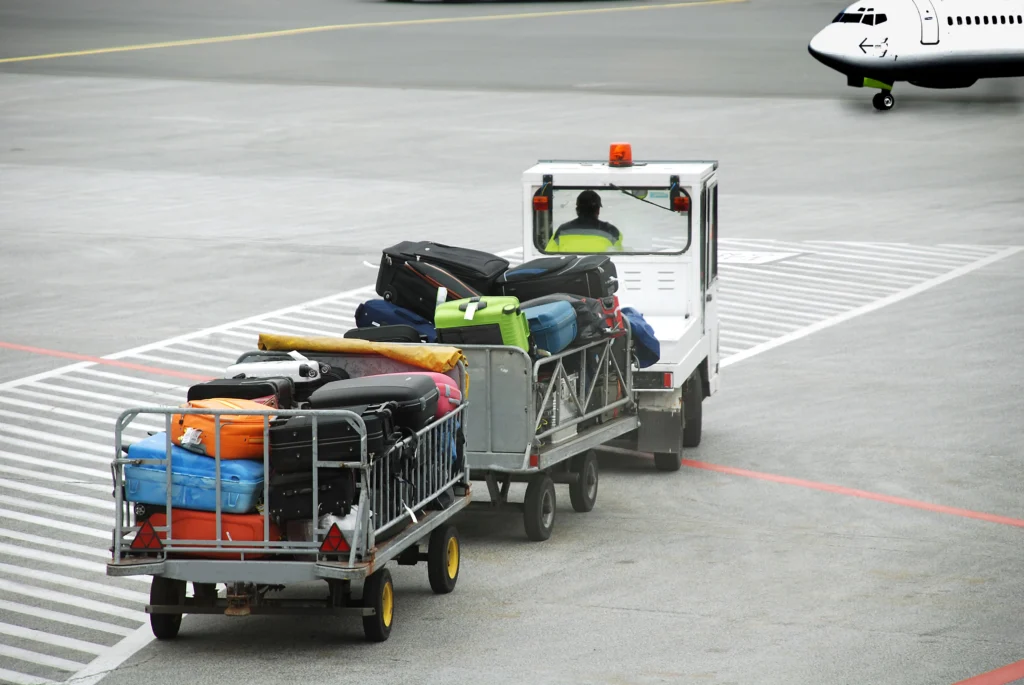UL Standards & Engagement recopila datos de incidentes de embalamiento térmico a través del Programa de Incidentes de Fuga Térmica (TRIP) y encuesta a los pasajeros aéreos para conocer mejor los riesgos y realidades del desbordamiento térmico en la aviación. Este informe ofrece el segundo análisis anual de estos resultados.
¿Cuál es el riesgo?
Los dispositivos recargables, como teléfonos, ordenadores portátiles, tabletas y baterías, son esenciales en los viajes aéreos modernos. Pero a medida que se generaliza el uso de baterías de iones de litio en estos y otros productos de consumo, sigue aumentando el riesgo de peligros para la seguridad.
Estos riesgos se complican a 40.000 pies.
Si están dañadas, mal cargadas, mal fabricadas o falsificadas, las baterías de iones de litio pueden entrar en un proceso denominado desbocamiento térmico, que se produce cuando las baterías se sobrecalientan, lo que plantea graves riesgos que incluyen el incendio o incluso la explosión. Los incendios de baterías de iones de litio arden con una velocidad y un calor intensos, lo que puede causar daños importantes y generalizados en cuestión de segundos. También pueden ser más difíciles de extinguir que los incendios de otros materiales.
PRINCIPALES CONCLUSIONES
Pase el ratón por encima de cada estadística para obtener más información sobre las conclusiones del informe.
Índices y tendencias de los incidentes de fuga térmica
En 2024, una media de dos vuelos por semana experimentaron un incidente de fuga térmica. Aunque se produjo un ligero descenso en el número total de incidentes de vuelos de pasajeros notificados en comparación con 2023, el descenso marginal hace que el total de incidentes de 2024 sea el segundo más alto desde 2019 con 11 incidentes.
18% de los vuelos de pasajeros que experimentan un incidente a bordo dan lugar a un aterrizaje desviado, regreso a la puerta de embarque, evacuación de emergencia o desembarque imprevisto.
Opinión de los pasajeros y la tripulación sobre la seguridad
¿Sabe lo que puede llevar en el equipaje?
Hemos preguntado a pasajeros reales por sus hábitos de equipaje y sus respuestas pueden sorprenderle. La mayoría de los pasajeros no tienen ni idea de que están infringiendo una norma de seguridad que podría retrasar el vuelo... o algo peor.
Se resistía a entregarlo, pero no podíamos arriesgarnos a un incendio en el cielo
Un miembro de la tripulación recuerda el tenso intercambio que se produjo cuando un pasajero dudó en abandonar su aparato sobrecalentado en pleno vuelo.
Este error común durante el vuelo puede suponer un riesgo de incendio
Un auxiliar de vuelo explica por qué recuperar uno mismo un teléfono perdido no sólo es incómodo, sino que puede ser peligroso. La mayoría de los pasajeros no tienen ni idea.
Un portátil, un gran retraso en el vuelo
Un tripulante de cabina recuerda cómo el olvido de un ordenador portátil en la maleta facturada de un pasajero provocó un gran retraso, poniendo de relieve una norma de seguridad que demasiados viajeros pasan por alto.

¿Sabe lo que puede llevar en el equipaje?

Se resistía a entregarlo, pero no podíamos arriesgarnos a un incendio en el cielo

Este error común durante el vuelo puede suponer un riesgo de incendio

Un portátil, un gran retraso en el vuelo
Dónde y cuándo se producen los incidentes
Los datos de TRIP cubren la totalidad del viaje aéreo, desde que el pasajero entra en el aeropuerto hasta que recoge su equipaje al final del trayecto. En 2024, la gran mayoría (89%) de los incidentes fueron reportados en la aeronavey los 11% restantes tuvieron que ver con el equipaje facturado y los objetos transportados por los pasajeros. Los incidentes ocurridos en el avión aumentaron ligeramente respecto a los 87% de los datos de 2023. Lamentablemente, en 77% de los incidentes no se indica la causa presunta del suceso en los informes presentados por las tripulaciones de vuelo.
Más de la mitad (52%) de los incidentes se produjeron durante la fase de crucero. Otros 15% de incidentes se produjeron durante las fases críticas del vuelo (despegue, ascenso, descenso, aproximación final y aterrizaje). Durante estas fases, el riesgo es inherentemente mayor: los pilotos están ocupados y los pasajeros no pueden evacuar.
EXPLORA
Pase el ratón por encima del trayecto para ver donde y cuando se producen incidentes.

11%
de los incidentes se produjeron fuera del avión, entre el aeropuerto y la recogida del equipaje.
89%
de incidentes de 2024 se registraron en la aeronave.
15%
de los incidentes se produjeron durante las fases críticas del vuelo (despegue, ascenso, descenso, aproximación final y aterrizaje).
52%
de los incidentes se produjeron durante las fases de crucero.
ESTUDIO DE CASO:
¿Qué debemos aprender tras el incendio de Air Busan?
Una reciente oleada de incidentes de escapes térmicos está haciendo que el problema sea más visible para el público viajero. Un avión de Air France con destino al Caribe se vio obligado recientemente a dar media vuelta en pleno vuelo después de que a un pasajero se le cayera un teléfono. Un vuelo de Hawaiian Air tuvo que realizar un aterrizaje de emergencia en Japón. En mayo, un vuelo de Southwest tuvo que regresar a la puerta de embarque en El Paso después de que el teléfono de un pasajero se incendiara.
Uno de los incendios de baterías más aterradores de los últimos años se produjo en enero, cuando un supuesto banco de baterías -del tipo con el que viajan 29% de los pasajeros estadounidenses- entró en embalamiento térmico, provocando una catástrofe. daños a un avión de Air Busan en Corea del Sur.

El banco de energía estaba comprimido en el compartimento superior y se incendió. Afortunadamente para los 169 pasajeros y los siete miembros de la tripulación, el avión aún no había despegado cuando las llamas arrasaron el aparato y todos pudieron escapar. El avión fue un siniestro total.
El incidente atrajo la atención y el escrutinio de la comunidad aeronáutica y los medios de comunicación internacionales. Cuando las noticias se centraron en las medidas que están tomando las aerolíneas asiáticas para evitar otro incidente como el de Air Busan, se puso de manifiesto una tendencia clara: todas las medidas coercitivas iban dirigidas a las baterías portátiles. Aunque ninguna aerolínea ha prohibido a los pasajeros llevar baterías de más de 100-160 vatios-hora, la mayoría han tomado medidas estrictas sobre lo que está permitido durante el vuelo.
Sin embargo, esta acción específica del producto es un objetivo demasiado estrecho. La causa del incendio fue la fuente de alimentación del producto, una batería de iones de litio.
Las secuelas de la avería del vuelo de Air Busan son visualmente alarmantes. También es una advertencia para no esperar a hacer cambios que mejoren la seguridad en el aire.
Invertir la tendencia
Dado que los pasajeros llevan a bordo más dispositivos alimentados por baterías de iones de litio -y que el número de viajeros ha vuelto a los niveles anteriores a la pandemia-, no es de extrañar el correspondiente aumento de incidentes de desbocamiento térmico. Pero eso no significa que sea aceptable.
- Educación de los pasajeros: Las encuestas de ULSE muestran una alarmante falta de concienciación y un comportamiento preocupante entre los pasajeros de las aerolíneas estadounidenses. Una educación clara, repetida y contextualizada sobre el tema ayudará a los pasajeros a contribuir a reducir el riesgo.
- Formación de tripulantes de cabina: Según las entrevistas y encuestas de ULSE con profesionales de la aviación, toda la tripulación de cabina recibe formación para responder a incidentes de fuga térmica a bordo de un avión. Una formación que esté vinculada a los equipos disponibles, que se evalúe y revise periódicamente y que reproduzca escenarios comunes del mundo real mejorará la formación que recibe la tripulación de cabina.
- Normas para el manejo de aeronaves y equipajes: Para ayudar a mitigar incidentes potencialmente catastróficos, ULSE publica normas que abordan los riesgos y peligros del desbordamiento térmico. Estas normas incluyen la UL 5800, Battery Fire Containment Products; la UL 5840, Electrical Systems of Battery Powered Aviation Ground Support Equipment; y la próxima UL 5810, Active Fire Protection for Air Cargo Containers.
Descargue el informe completo para ver más detalles sobre la fuga térmica en incidentes de aviación en 2024, así como para aprender cómo las asociaciones entre la industria, el gobierno y otras partes interesadas pueden reforzar los esfuerzos colectivos y ayudar a impulsar un cambio impactante.

¿Quiere saber más?
Más información
Programa de Incidentes de Fuga Térmica
UL Standards & Engagement lidera el Programa de Incidentes de Fuga Térmica (TRIP), un sistema de notificación voluntaria diseñado para que el sector de la aviación comprenda mejor el alcance del problema y se prepare para futuros incidentes o, en el mejor de los casos, los evite.
Participantes de 37 aerolíneas de pasajeros y de carga proporcionan información detallada sobre incidentes en sus operaciones. La información se anonimiza y se comparte con la industria de la aviación y las organizaciones de seguridad, ofreciendo perspectivas para mejorar la seguridad del transporte y el uso de mercancías impulsadas por baterías de iones de litio. La base de datos TRIP funciona como una herramienta de vigilancia, diseñada para recopilar datos sobre la frecuencia, las características y las consecuencias de los incidentes de fuga térmica de baterías de iones de litio en operaciones de pasajeros y de carga.
La Administración Federal de Aviación también recopila datos sobre incidentes de huida térmica. Los datos de la FAA proceden de los informes federales obligatorios, mientras que TRIP incluye informes adicionales de cada etapa del proceso de viaje al tener en cuenta los incidentes en la terminal, la facturación de equipajes, los controles de seguridad y la salida de la recogida de equipajes.